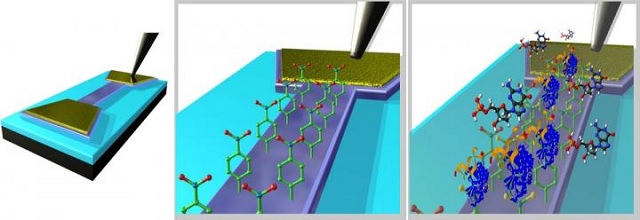 This is an illustration of an epitaxial graphene channel biosensor for detection of targeted 8-hydroxydeoxyguanosine (8-OHdG) biomarker. (A) Schematic of MLEG device (B) Thin film of covalently attached nitro phenyl (PhNO2) groups on the MLEG channel. (C) Attachment of the 'bioreceptor' antibody anti-8-OHdG to the amine terminated MLEG channel and subsequent detection of 8-OHdG. Image Credit: 2D Materials.
This is an illustration of an epitaxial graphene channel biosensor for detection of targeted 8-hydroxydeoxyguanosine (8-OHdG) biomarker. (A) Schematic of MLEG device (B) Thin film of covalently attached nitro phenyl (PhNO2) groups on the MLEG channel. (C) Attachment of the 'bioreceptor' antibody anti-8-OHdG to the amine terminated MLEG channel and subsequent detection of 8-OHdG. Image Credit: 2D Materials.
A team of researchers from the University of Swansea have developed a highly sensitive graphene biosensor with the capability to detect molecules which show signs of increased cancer risk.
The newly developed graphene biosensor could help to provide a rapid diagnosis at the point-of-care. In comparison with other bioassay tests, this sensor was over five times more sensitive.
Conventionally, graphene is produced using an exfoliation technique in which layers of graphene are stripped from graphite. However for a biosensor, a large substrate area is required in order to produce patterned graphene devices.
The researchers used conditions of low pressure and very high temperatures in order to grow graphene on a substrate of silicon carbide. The graphene devices were then patterned by using methods similar to those used when processing semiconductors. The team then attached bioreceptor molecules that could bind to specific target molecules in urine, saliva or blood.
In order to verify if the bioreceptor molecules were bound to the graphene biosensor, the researchers used Raman spectroscopy and x-ray photoelectron spectroscopy. The biosensor was then exposed to various concentrations of 8-hydroxydeoxyguanosine (8-OHdG) molecule.
When high amounts of DNA damage occur, 8-OHdG is produced which is connected to a high risk of cancer development. Traditional detection tests, such as the enzyme-linked immunobsorbant assays (ELISAs), are not capable of detecting the low concentrations of 8-OHdG in urine.
The graphene sensor had the capability to detect low concentrations of 8-OHdG at a comparatively faster rate. Dr Owen Guy, the study’s co-author, stated that the properties of graphene make it ideal for fabricating biosensors. The paper has been published in 2D Materials, a journal of IOP Publishing.